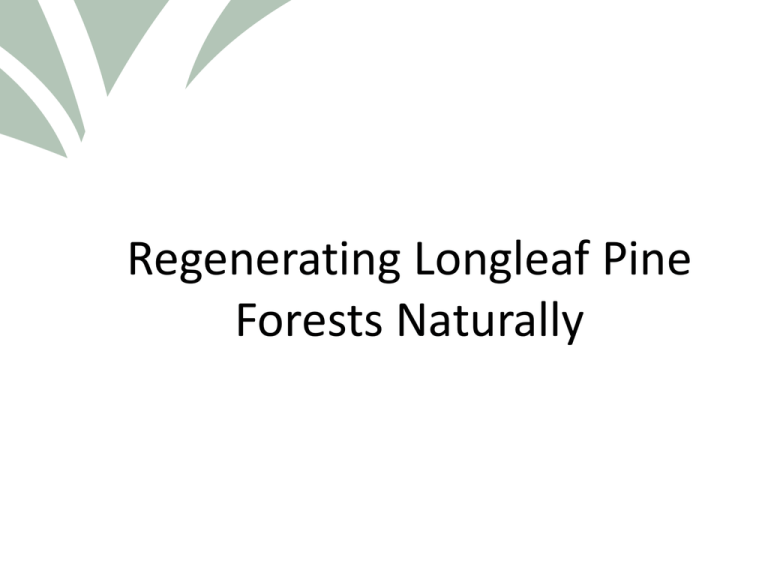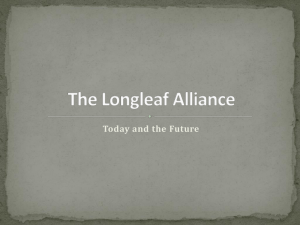Regenerating Longleaf Pine Forests Naturally Powerpoint
advertisement

Click to edit Master title style Regenerating Longleaf Pine Forests Naturally ClickNatural to edit Regeneration Master title style Click to edit Master title style Mature Longleaf Forest Click to Relevant edit Master title style Facts • The southern pines are generally shade intolerant • Natural disturbances occur on many scales • Southern pines occur naturally in both evenaged and uneven-aged systems ClickManagement to edit Master title style Choices • Natural regeneration: • Requires a suitable, well distributed seed source • Can be used in even-aged and uneven-aged management systems • Sacrifices advantages of stocking control for low “upfront” regeneration costs • Uncertain seed crops make planning difficult if time is a factor Click to edit Master title style Effect of gap size on stand conditions • Small gaps or small scale disturbances can lead to stands of multiple ages as the gaps are filled in with regeneration. • Large gaps can result in even-aged stands, with all trees being regenerated within a few years of each other following the disturbance. Current Southern Pine Management Click to edit Master title style Trends • Most southern pines are managed today in even-aged systems : – Optimizes growth rates by allowing maximum sunlight on growing crop – Takes advantage of economies of scale for silvicultural treatments – Enables easy scheduling for harvests, treatments Trends favoring uneven-aged Click to edit Master title style management • Changing landowner demographics, owner’s objectives may favor uneven or allaged management because: Click toFavoring edit Master title style Trends – Retains appearance and much of the function of a forest throughout – Can take advantage of natural regeneration, reducing upfront costs Click to edit Master title style Regeneration • In all regeneration systems, the greatest challenge is to get reliable and timely regeneration and give it room to grow into the larger, more valuable size classes Click to edit Master title style Regeneration Management • Competition may be intra-specific or interspecific • Control usually means control of competing vegetation or release harvest • Intermediate cuts, herbicides and fire are techniques of choice in most southern pine management schemes Click to edit title style Regeneration andMaster Species Considerations • Longleaf Pine – Sporadic seed producer – Seed generally only disperses 100 feet or so from the seed tree ClickLongleaf to edit Master title style Pine (contd.) – Fire tolerant at virtually any size after year of germination – Could be planted in gaps to augment natural seedling numbers – Two year cones allow for some planning and preparation Regenerating degraded stands Click to edit Masterlongleaf title style naturally.. • The shelterwood system, as utilized in longleaf management, can result in either even-aged or multi-aged longleaf stands. • The first step in natural regeneration should be to control the woody understory prior to opening up the canopy with a cut. • Fire, particularly growing season fire, or fire and herbicide used in combination can be effective in this effort. Combinations of dormant season and growing season fires may be necessary to reduce initial fuel loads. Click to edit Master title style Mixed Pine Stands Click to edit Master title style Mixed pine stands • If sufficient numbers of well-distributed longleaf are present in the overstory to provide some seed, the stand can be managed to regenerate naturally. • Fire should be a regular part of a management regime until woody understory competition is controlled. • One treatment to control woody brush that has proven successful employs Garlon 4TM (triclopyr) applied with ground equipment or backpack sprayers in early Fall, followed by an early Spring fire. • Fire must be employed to prevent seedlings from other pine species from occupying the site before longleaf can become established. Longleaf has sporadic seed crops, unlike the annual seed crops of other southern pines, and may fail to capture the openings when they occur. Mixed stands containing other pine species might be thinned to create gaps to release longleaf seedlings already present in the understory Click to edit Master title style ClickMixed to editpine Master title style stands… • Successive cuts to increase the number and/or size of the previous gaps will create a mixed stand of several age classes, that will, over time, become an all-aged longleaf stand. • It may be desirable to keep some pines of species other than longleaf in the overstory to help provide fuel for fires. • It is difficult to burn into the center of gaps larger than ¼ acre because of the lack of pine fuels. Click to edit Master title style Even-aged natural • • • • • • • Low upfront costs Fairly consistently successful Stocking control can be a problem Growth on best trees Best trees at risk Unreliable seed production Can be used to begin transition to all-aged stand condition (Modified Shelterwood) Click edit Master System.. title style ThetoShelterwood • When the understory is reduced to a manageable level, a preparatory cut is used to reduce Basal Area to 50 to 60 square feet per acre, favoring trees of good form, large crowns, and good seed producers. The residual trees should be well-distributed across the area. • After several years, the crowns will have expanded into the intervening gaps and regeneration has begun to accumulate. At that time, a second “seed” cut should be used to reduce Basal Area to 25 to 30 square feet per acre, again favoring well formed good seed producers distributed evenly across the stand. • When a good seed crop is anticipated (through flower and/or cone crop counts), the stand should be burned in the winter or early growing season prior to seed fall to prepare a good seed bed. The seedto cutedit should lower title basalstyle area to Click Master about 30 square feet per acre Click to edit Master title style Shelterwood Regeneration • Longleaf is a sporadic seed producer, producing seed anywhere from annually to once every 20 years in some areas. • Longleaf is a “two-year” cone, with female cones or flowers appearing one year and maturing the next, the year of seed fall. • Surveys of female flowers anticipate cone crops but can be difficult for inexperienced observers. Cone counts are easier, but give less lead time to prepare the site to receive seed. • There should be about 30 cones per tree or 1000 cones per acre to provide adequate seed to naturally regenerate an entire area with longleaf seed. Cone or to flower can title guidestyle natural Click editcounts Master regeneration decisions to edit title style on OneClick and two year Master cones may be present the same branch Almost anyone count title cones,style but it Click to editcan Master takes a trained eye to count flowers ClickShelterwood to edit Master title style Systems • A minimum of 4,500 germinants per acre are considered sufficient to consider a site successfully regenerated from natural seed. At least 75% of all 0.001 acre plots should have at least one live seedling present. • If the above conditions can be met, the site can be considered stocked with new seedlings and, if desired, the overstory trees removed within two years of the seed year. This will yield an even-aged stand. ClickShelterwood to edit Master title style system.. • Naturally regenerated stands cannot be burned in the year following seedfall without endangering the new seedlings. Seedlings with a root collar diameter of 0.25 inch or greater generally can survive most fires. • If even-aged stands are not desirable, all or a portion of the seed trees may be retained, creating a two-aged stand. Subsequent repetitions of this process with later seed crops will eventually yield a multi-aged stand. • Seedling growth rates may be adversely affected by competition from the residual overstory. Click regenerated to edit Master title have stylefrom Naturally stands should 4,500 to 6,000 seedlings per acre the spring after seed fall Click to edit Master title style Harvesting the Overstory Click to edit Master title style New longleaf seedlings cannot survive fires until they reach a root collar diameter of at least 0.25 inches (6 mm) Retaining all of the seed trees Click tosome edit or Master title style produces a two aged stand Click to edit Master title style Shelterwood with Retention • Overstory of 30-40 square feet of BA removed in several stages over an extended period to allow several cohorts of seedlings to develop, potentially creating an uneven-aged stand. • Because longleaf is a sporadic seed producer, seed crops may be several years apart. ClickUneven-aged to edit Master title style Systems • Longleaf stands or stands that are predominantly occupied by longleaf may also be regenerated and managed using uneven-aged systems. Click to edit Master title style Uneven-aged choices.. • Stands may be managed in uneven aged conditions using several natural management alternatives, assuming regeneration is obtained. • Single tree selection • Group selection • Stoddard-Neel System • Reverse “J” or BDQ method Overview of “Natural” Standtitle Management Click to edit Master style (Uneven-Aged) • • • • • • Retains appearance of a “forest” Retains full range of habitat/species diversity Retains market flexibility Can require individual attention Economies of scale may be limiting Should obtain regeneration catch before creating gaps to release it ClickOverview to edit Master title style (Continued) • Provisions must be made for regeneration and fire • Produces constant flow of high value timber and non-timber products • Requires fairly frequent entries and disturbances to yield comparable income • Requires “informed” management to be successful • No upfront establishment costs Creating uneven agetitle forest from Click tothe edit Master style regeneration • With each successive seed crop, gaps can be created or enlarged to release the new seedlings. • Gaps can be systematically or randomly located depending on the landowner’s objectives • “Domes” of regeneration take shape over time, with the tallest seedlings in the center. Click to edit Master title style Regeneration “Domes” ClickAll-Aged to edit Master title style or “All-Sized” • Makes little difference for future management since longleaf responds to release at almost any age unless critically suppressed. • Longleaf grows naturally at different rates, possibly as a hedge against lethal fires. Click to edit Master title style “All-aged” or “All-sized” Click toStocking edit Master title style control • When natural regeneration works, it can work too well. • The 1996 seed crop resulted in some stands at the Dixon Center with over 400,000 longleaf germinants per acre • Fire, drought and other mortality factors gradually reduced those numbers, but some stands retained high levels of stocking Click to Over-stocked? edit Master title style ClickSeedbed to edit Master title style preparation • If seeds fall on deep litter, they typically germinate anyway, but die at the first dry spell or first fire because roots are anchored in mineral soil. • If seeds fall on bare soil, seed predators may devour the crop unless it is an unusually large crop. Click to editTasty Master title style ? • Not only is longleaf seed tasty and preferred by birds, small mammals, and other predators, it is edible and palatable for humans. At the current rate of $160 per pound, it would be an expensive meal. • The new germinants reportedly make a tasty addition to salads! Click to edit Master title style Questions???





